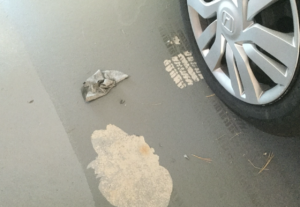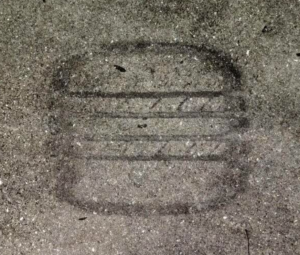Have you ever noticed the black smudges on the floor of your garage, workshop, or commercial space? These are what are known as hot tire pick up on epoxy floors. Hot tire pick up is a common issue that affects homeowners and businesses alike, as epoxy floors are popular for industrial and residential uses, especially in the hot southeast region like Charlotte and surrounding areas. Yet, not everyone is aware of what hot tire pick up is or how to deal with it. In this article, we will discuss everything you need to know about hot tire pick up on epoxy floors, from what it is and how it forms to how to remove it and how to prevent it from forming in the first place. Armed with this knowledge, you can quickly and easily get rid of hot tire pick up and keep your epoxy floor looking its best.
What is Hot Tire Pick Up?
Hot tire pick up is a type of staining that appears on epoxy floors, usually in the form of dark smudges. It’s caused when rubber from the tires of a vehicle, such as a car or truck, comes into contact with the epoxy flooring and leaves behind a dark residue. Hot tire pick up is most common in garages, driveways, and other areas where vehicles are parked for extended periods of time.
When rubber from a vehicle’s tires comes into contact with an epoxy floor, it can be left behind in the form of a stain. The rubber material will stick to the floor, leaving behind a dark, sticky residue. Hot tire pick up is most often caused by rubber from the tires of hot vehicles, such as those that have just been driven or are in the process of being driven. The heat from the vehicle’s tires will cause the rubber to stick to the epoxy floor, resulting in hot tire pick up.
The severity of hot tire pick up will depend on the type of epoxy flooring and the type of rubber used in the vehicle’s tires. In some cases, hot tire pick up may be more severe if the epoxy floor is older or if the rubber material is particularly stickier or harder.

How Does Hot Tire Pick Up Form?
Hot tire pick up is caused when the rubber from the tires of a vehicle comes into contact with an epoxy floor. The rubber will stick to the epoxy floor, leaving behind a dark, sticky residue. Hot tire pick up is most often caused by rubber from the tires of hot vehicles, such as those that have just been driven or are in the process of being driven. The heat from the vehicle’s tires will cause the rubber to stick to the epoxy floor, resulting in hot tire pick up.
Hot tire pick up can occur when vehicles are parked in a garage or driveway, or when they are driven on the epoxy floor. As the rubber from the tires makes contact with the epoxy floor, it sticks to the surface and cannot be easily removed. The rubber will then be visible as a black smudge or stain on the epoxy floor.
Hot tire pick up can also occur when vehicles are parked in the same spot for a long period of time. The rubber from the tires will gradually build up on the epoxy floor and can become difficult to remove.
What Are the Effects of Hot Tire Pick Up?
Hot tire pick up can have a number of negative effects on an epoxy floor. For one, it can make the floor look unattractive and can reduce the overall aesthetic appeal of a space. Hot tire pick up can also make the floor more difficult to clean, as the rubber material will be more difficult to remove. In some cases, it can even cause the epoxy floor to become damaged or cracked if the rubber material is not removed in a timely manner.
Hot tire pick up can also lead to the development of other problems on an epoxy floor, such as dirt and debris buildup. As the rubber material builds up on the floor, it can act as a magnet for dirt and debris, which can further damage the epoxy floor.

How to Remove Hot Tire Pick Up
The best way to remove hot tire pick up from an epoxy floor is to use a degreaser or solvent. A degreaser or solvent will be able to break down the rubber material and make it easier to remove. When using a degreaser or solvent, it is important to follow the manufacturer’s instructions and use the product in a well-ventilated area.
Once the degreaser or solvent has been applied, it should be left to sit on the hot tire pick up for several minutes to allow it to break down the rubber material. After the degreaser or solvent has been allowed to sit, it should be wiped off with a clean cloth or sponge.
It is also important to note that some epoxy floors may require special cleaning products to remove hot tire pick up.
How to Prevent Hot Tire Pick Up
The best way to prevent hot tire pick up from forming is to limit the amount of time that vehicles are parked in the same spot. Moving a vehicle every few hours can help to prevent the rubber from the tires from sticking to the epoxy floor.
It is also important to use a sealant on the epoxy floor. A sealant will help to create a barrier between the rubber from the tires and the epoxy floor, preventing the rubber material from sticking to the surface. It is important to follow the manufacturer’s instructions when applying a sealant to an epoxy floor.
Finally, it is important to regularly clean the epoxy floor. Regular cleaning will help to remove any dirt and debris that may be stuck to the floor, reducing the chances of hot tire pick up.
Different Types of Epoxy Flooring
Epoxy flooring is a popular flooring choice for both industrial and residential spaces. There are many different types of epoxy flooring available, each with its own unique benefits and drawbacks. If you are considering a new epoxy floor, our team here at Dogwood Epoxy in Charlotte will be glad to meet with you and discuss the right type of floor and how to address hot tire issues.
The most popular type of epoxy flooring is self-leveling epoxy, which is a two-part system that consists of a primer and a top coat. Self-leveling epoxy is ideal for areas that require a smooth, durable surface, such as garages, warehouses, and commercial spaces.
Another type of epoxy flooring is decorative epoxy, which is a thicker, more durable type of epoxy that can be used to create custom designs and patterns. Decorative epoxy is ideal for areas that need to be aesthetically pleasing, such as residential spaces or retail stores.
Finally, there is colored epoxy, which is a type of epoxy that is available in a variety of colors and finishes. Colored epoxy is ideal for areas that need to have a specific color or aesthetic, such as a family room or office.
Benefits of Epoxy Flooring
Epoxy flooring is a popular choice for both industrial and residential spaces due to its many benefits. Epoxy flooring is a durable and long-lasting flooring option that is resistant to scratches, stains, and wear and tear. It is also easy to clean and maintain, making it a great choice for areas that require frequent cleaning.
Epoxy flooring is also highly customizable and can be easily customized to fit any space. Epoxy flooring is available in a variety of colors and finishes, allowing you to create the perfect look for your space. Additionally, epoxy flooring can be enhanced with decorative elements, such as logos or patterns, to create a unique aesthetic. For more details about customizing your floor, give us a call if you are in the Charlotte area.
Finally, epoxy flooring is a cost-effective flooring option that can help to reduce energy costs. Epoxy flooring is highly reflective and can help to reflect natural light, reducing the need for artificial lighting and resulting in lower energy bills.

Maintenance Tips for Epoxy Floors
Epoxy floors require regular maintenance to keep them looking their best. Here are some maintenance tips for epoxy floors:
- Clean the floor regularly. Regularly cleaning the epoxy floor will help to remove dirt and debris that can cause staining and discoloration.
- Use the right cleaning products. It is important to use the right cleaning products for an epoxy floor. Consult Dogwood Epoxy to determine the best cleaning products to use.
- Seal the floor. Applying a sealant to the epoxy floor will help to create a barrier between the rubber from the tires and the epoxy floor, preventing the rubber material from sticking to the surface.
- Move vehicles regularly. Moving a vehicle every few hours can help to prevent the rubber from the tires from sticking to the epoxy floor.
Common Mistakes with Epoxy Floors
Epoxy floors are a popular choice for both industrial and residential spaces, but there are some common mistakes that can be made when it comes to epoxy flooring.
One common mistake is not using the right cleaning products. It is important to use the right cleaning products for an epoxy floor.
Another mistake is not sealing the floor. Applying a sealant to the epoxy floor will help to create a barrier between the rubber from the tires and the epoxy floor, preventing the rubber material from sticking to the surface.
Finally, not regularly cleaning the floor is another mistake that can be made. Regularly cleaning the epoxy floor will help to remove dirt and debris that can cause staining and discoloration.
The Recap
Hot tire pick up is a common issue that affects homeowners and businesses alike, as epoxy floors are popular for industrial and residential uses. Hot tire pick up is caused when rubber from the tires of a vehicle comes into contact with an epoxy floor and leaves behind a dark, sticky residue. Hot tire pick up can be removed with a degreaser or solvent, and it can be prevented by limiting the amount of time that vehicles are parked in the same spot and by using a sealant on the epoxy floor. Additionally, it is important to regularly clean the epoxy floor to reduce the chances of hot tire pick up. Armed with this knowledge, you can quickly and easily get rid of hot tire pick up and keep your epoxy floor looking its best.
For more information about hot tire pick up or installing a new epoxy floor in your home, please give us a call for a free estimate.
We serve approximately 35 miles around the Charlotte area:
- Monroe
- Ballantyne
- Waxhaw
- Gastonia
- Huntersville
- Cornelius
- Mooresville
- Concord
and more.
We look forward to serving you.

